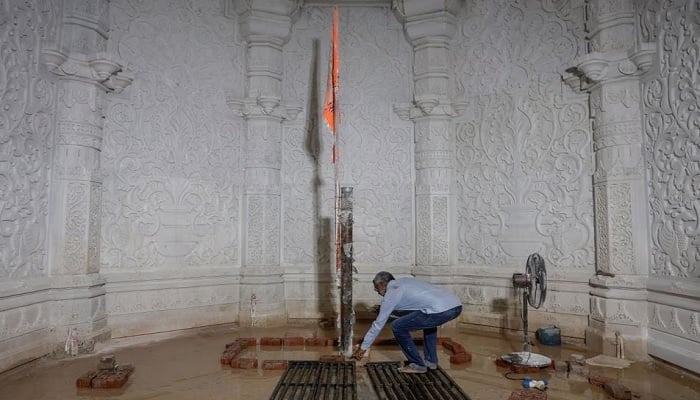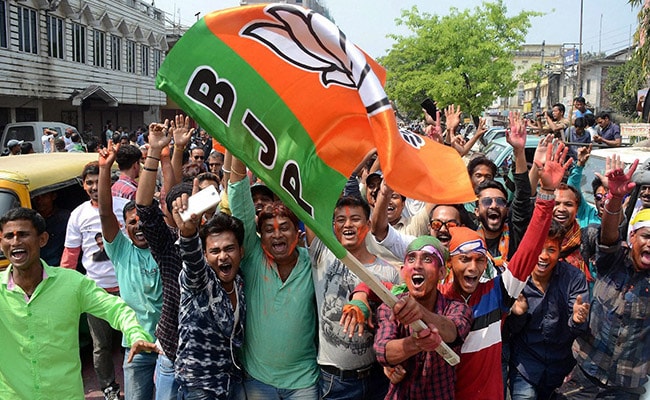
AYODHYA: The initial phase of the Ram Temple construction in Ayodhya, a northern town in India, is set to conclude in December and will be open to devotees in January, an Indian official said on Thursday.
The site where the temple is being constructed was the subject of a contentious dispute between Hindus and Muslims for many years.
Hindus claim the site as the birthplace of Lord Ram and consider it sacred, with historical significance preceding the construction of the Babri mosque by Muslim Mughals in 1528. In 1992, a Hindu mob destroyed the mosque, leading to widespread riots across India in which approximately 2,000 people lost their lives, primarily Muslims.
India’s Supreme Court awarded the site to Hindus in 2019, paving the way for the construction of a Hindu temple, a plan long supported by Prime Minister Narendra Modi’s ruling Hindu-nationalist party.
Modi has been invited to take part in the prayers at the opening ceremony, Nripendra Misra, Chairman of the Shri Ramjanmabhoomi Temple Construction Committee, told reporters.
“The ground floor (of the temple) will be completed in December 2023 and once it is completed and once the lord has moved to the sanctum sanctorum …we have to permit devotees to come and pray,” Misra said.
The dispute
The demolition of the centuries-old Babri mosque by a Hindu mob in the Indian holy town of Ayodhya in late 1992 sparked deadly religious riots around the country, killing about 2,000 people.
Here are key facts about the disputed site, sourced from court and government documents.
The Hindu epic scripture Ramayana mentions Ayodhya, located in the northern Indian state of Uttar Pradesh nearly 700 km (435 miles) from New Delhi, as the birthplace of the Hindu god-king Ram. He is believed to be a physical incarnation of Lord Vishnu, one of the principal deities of Hinduism.
In 1528, a mosque was constructed in Ayodhya under India’s first Mughal ruler, Babur. Many Hindus believe it was built on the exact birthspot of Lord Ram, where there is some evidence that a Hindu temple had once stood.
In December 1949, some Hindu activists placed idols of Ram inside the disputed structure, leading to the mosque’s seizure by authorities. Court orders restrained people from removing the idols, and the structure’s use as a mosque effectively ceased from that point.
Hindu and Muslim groups filed separate claims over the site and the structure. In 1989, the Allahabad High Court ordered the maintenance of the status quo.
Mosque razed
The Hindu nationalist organisation Vishva Hindu Parishad (VHP) and the Muslim group All India Babri Masjid Action Committee tried unsuccessfully to resolve the dispute through negotiations.
Then in 1991, when the Hindu nationalist Bharatiya Janata Party (BJP) of current Indian Prime Minister Narendra Modi came to power in Uttar Pradesh, the campaign for the construction of a Ram temple grew.
The state government started acquiring land adjoining the disputed structure, with the idea that Hindu volunteers would build a temple there without touching the mosque. However, the proposal was rejected by a state court.
On Dec. 6, 1992, a group of Hindus who had gathered for a rally near the site climbed the mosque and started damaging the domes with axes and hammers. Within a short time, the entire structure was razed to the ground.
The then President of India, Shankar Dayal Sharma, assumed all the functions of the Uttar Pradesh government and dissolved the state assembly. The federal government acquired all the disputed land, expanding the area to 67.7 acres through an executive order in 1993.
Court orders
In September 2010, the Allahabad High Court ruled that the main site where the mosque once stood should be split into three parts, one for Muslims and two for Hindus.
In its order, the court laid out the difficulty in making a decision on such a sensitive topic.
“Here is a small piece of land where angels fear to tread. It is full of innumerable landmines. We are required to clear it,” the three-judge bench wrote.
“Some very sane elements advised us not to attempt that. We do not propose to rush in like fools lest we are blown. However we have to take risk. It is said that the greatest risk in life is not daring to take risk when occasion for the same arises.”
Please visit our website London Institute of Peace Research for latest peace news


